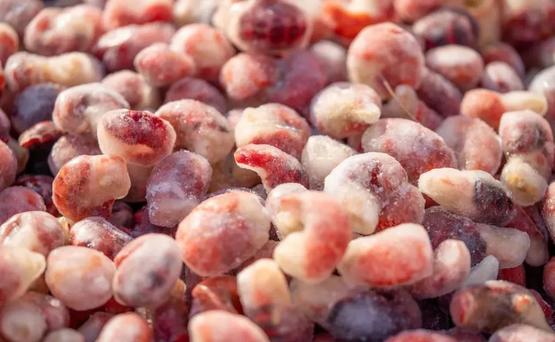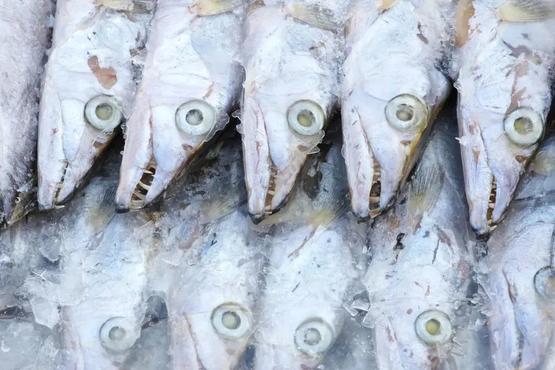You have probably experienced the following experience. You thawed a pack of quick-frozen shrimp, and you only needed a small part for cooking, so you put the rest in the freezer and re-frozen for the next time. In fact, this is not a very good practice.
Quick freezing: this winter is not too cold
The so-called quick freezing, as the name suggests, is to freeze quickly . By reducing temperature and water activity, various chemical reactions are inhibited and food spoilage is delayed. The quick freezing process involves the crystallization of water molecules. In short, the slower the cooling rate, the larger the ice crystals formed by the water molecules. Therefore, the purpose of rapid cooling is to make the ice crystals formed by water as small as possible, so as not to damage the integrity of food microstructure as much as possible. In fact, if the cooling rate is fast enough (for example, using liquid nitrogen to quickly cool down to below minus 135 degrees Celsius), water will exist as a high-viscosity liquid without ice crystals at all. However, this technology is usually only used on “essence” resources such as frozen sperm and eggs, and it is unlikely to be applied to food. First, the food volume is too large to quickly reduce the center temperature; second, the cost of such a rapid cooling is too high.

Figure 丨 Tu Chong Creative
So how fast and how low is the “quick freezing” in food processing? The usual requirement is to reduce the temperature of the food center to about minus 5 degrees Celsius within 30 minutes, and then store it in an environment of minus 18 degrees Celsius. Since the diameter of the ice crystals produced by such quick freezing is less than 100 microns, which is exactly the same size as the diameter of most animal cells (10-100 microns), the ice crystals will destroy the structure of the cell membrane in the food . This is also one of the reasons why the taste of quick-frozen food is not as good as that of fresh food.
However, these ice crystals are difficult to hurt smaller bacteria (about 0.5-5 microns in diameter), which means that such temperatures cannot freeze the bacteria to death at all, they just temporarily enter hibernation due to the decrease in temperature and water activity status only.
Thawing: Spring in Bacteria Class
Except for a few cold drinks such as ice cream, most foods still need to be thawed, reheated, or even cooked at high temperature before they can be eaten (what? Do you have good teeth? Just love to eat frozen octopus?). So two important changes will take place during the thawing process: one is the increase of temperature, and the other is the increase of water activity .

Figure 丨 Tu Chong Creative
When a piece of hairtail at minus 18 degrees Celsius warms up to room temperature, as the temperature and water activity rise, various chemical reactions that can cause food to deteriorate gradually accelerate, and the bacteria that were originally in a hibernating state also welcome spring. They all woke up. What do you think the first thing the bacteria see when they wake up? Because the cell membrane was damaged by ice crystals during the freezing process, the cell fluid flowed out after thawing. For bacteria, it is like a person who is about to faint when he suddenly sees delicious and tempting slices of boiled meat and shiny roasted chicken legs. And the ancients said that when you are full of warmth, you think about lust, and this is no exception for bacteria. What is even more frightening is that the reproduction of bacteria is exponentially increasing . In just a few hours at room temperature, the number of bacteria in this lump of hairtail may be doubled several times.
At this time, if you quickly make it into braised octopus and eat it, it will not cause health problems, but if you put it back in the refrigerator, it usually takes several hours to completely freeze the food from the inside to the outside due to the limited freezing effect of ordinary household refrigerators However, bacteria will still use this time to increase the “population base” of “class members” . In addition, this slow freezing process creates larger ice crystals, causing further damage to the hairtail cells. When it is thawed next time, due to the larger “population base” of bacteria and the more severely damaged hairtail cells, this miserable hairtail that has been frozen twice will be more likely to deteriorate in a short period of time. The consequence of rashly eating this sad reminder hairtail is likely to run to the bathroom with your stomach covered, or N times!

Such a delicious thing, why don’t you finish it all at once?丨 Tu Chong Creative
Secondary freezing of thawed food is not conducive to food preservation, and the risk of food deterioration will increase, so the thawed food should be eaten at one time as much as possible. For the safety of consumers, the European Union stipulates that all quick-frozen food packaging must be clearly marked “do not refreeze thawed food” .
Author: less screws
Edit: Forget Jianghu
This article comes from Guoke, and shall not be reproduced without authorization.
If necessary, please contact [email protected]

This article is transferred from: http://www.guokr.com/article/463331/
This site is only for collection, and the copyright belongs to the original author.